No sooner Captain Blood hit the cinemas Errol dabbled already in Texas Gold! Oil that is, black gold, Texas tea!
January 22. 1936
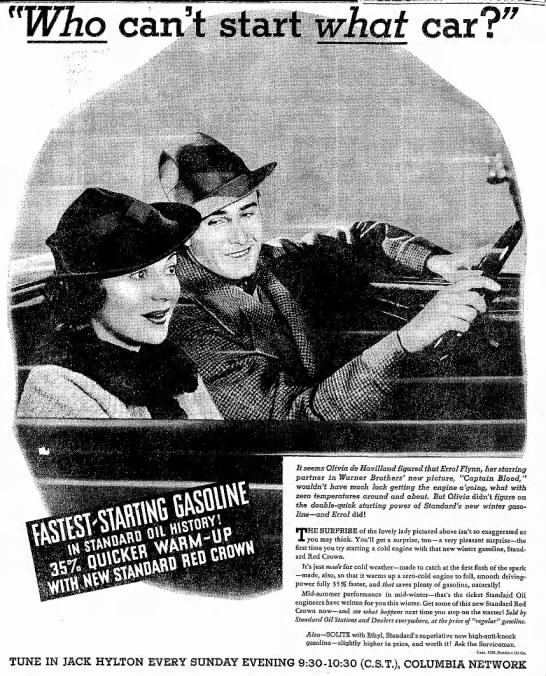
Hurray, I did it! Finally!
— Tina
No sooner Captain Blood hit the cinemas Errol dabbled already in Texas Gold! Oil that is, black gold, Texas tea!
January 22. 1936

Hurray, I did it! Finally!
— Tina
John Wilkes (1725 to 1797). Born in London to a middle class family, he was a journalist, writer, libertine, poet, adventurer, wit, radical MP, womaniser, duellist, fighter against oppression, and one of the first media celebrities.
Wilkes was also the most successful womaniser we English ever produced (at any rate, he was the most famous). He even managed to pinch Casanova’s favourite mistress, which the Italian moaned about in his memoirs. It must have been very galling as Wilkes wasn’t much to look at, having a crooked jaw and a squint, but as one smitten female put it, ‘he doesn’t squint more than a gentleman should!’
He began life as an adventurer, gaining access to aristocratic society by virtue of his wit and erudition. He soon found a patron in the Earl of Granville, a prominent Whig politician. Granville secured for Wilkes a safe seat and he entered the House of Commons. Wilkes then founded the North Briton, a newspaper which focused its acerbic satire on the incompetent ministry of Lord Bute. Issue No45 caused uproar in its unprecedented attack on the Government and by implication, the King. Wilkes became an instant celebrity in an era that had just embraced newspapers, with shops ‘cashing in’ in the form of figurines, pictures, cockades, pins and even parrots that repeated ’45 & Liberty.’ Wilkes literally caused riots, and people would tear off pieces of his clothes.
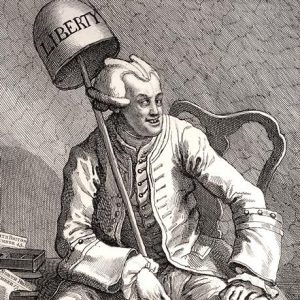
John Wilkes, drawn by his enemy William Hogarth
Even the Tory Dr Johnson was eventually won over by his charm and intelligence. Interestingly, he was referring to Wilkes when he famously said, ‘Patriotism is the last refuge of a scoundrel.’
Another reason Wilkes became infamous was his Flynning ways. A libertine who had lost his virginity aged 12, he liked to try everything and, in particular, every woman. He was elected a member of a secret society called the Monks of Medmenham, which later became known as the Hell Fire Club.
The men dressed as monks, and prostitutes were hired to dress as nuns. They were ferried by boat, at night, to the grounds of a ruined abbey on the banks of the Thames. Wilkes was known as ‘Brother John of Aylesbury’ and kept the cellar books. The quantities of claret and port consumed were quite extraordinary, even by the standards of the day.
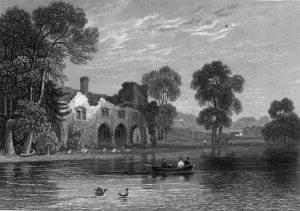
Medmenham Abbey
Wilkes loved to play practical jokes. In fact, it was said of him; ‘Jack Wilkes will sacrifice his best friend for a scurvy jest.’ Remind you of anyone? He once dressed an ape as the Devil, hid it in a chest and then unleashed it on an unsuspecting Lord Sandwich, who was then First Lord of the Admiralty.
After a few years, the ‘brotherhood’ disbanded. According to some, the orgies were relocated to the subterranean caves at West Wycombe Park in Buckinghamshire. West Wycombe, which is one of the first Palladian houses in Britain, belonged to fellow ‘monk,’ Sir Francis Dashwood, who had the grounds laid out to mimic the shape of a woman’s naked body.
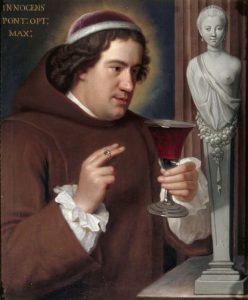
Sir Francis Dashwood, painted as a monk
Having been in the caves myself, however, I can say that they are cramped, freezing and very damp! Hardly conducive to nights of passion.

Entrance to the caves at West Wycombe Park

Inside the caves at West Wycombe
West Wycombe House


The house and, above, its private church with a hollow golden ball that could seat six men, and was used for drinking rum punches!

The Temple of Music
Wilkes had married young, to an older, wealthier woman. The marriage was not a success and he left, taking their daughter Polly, who was devoted to him and never married. When Wilkes had to escape to the Continent after the Parliament convicted him of ‘obscene libel’, Polly accompanied him.
After a sojourn in Italy, where Wilkes took up with a 15 year old countess who stole all his money, he returned to England, was imprisoned, re-elected to the House of Commons and went on to become Mayor of London and a supporter of American independence. He also established three vital English liberties; freedom of the press to report the proceedings of Parliament, freedom from arrest without charge, and the right to take your seat in Parliament if you have been democratically elected.
Errol would definitely have approved.
Wilkes died aged 72 at his home in Grosvenor Square and is buried in the Grosvenor Chapel, South Audley Street, London.

Grosvenor Chapel, Mayfair.
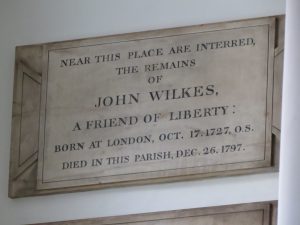
— PW
When Errol was in Mexico in the 1930s and visited the house of the renowned Marxist artist Diego Rivera, he met his then assistant, a moustachioed Englishman, who introduced himself as Jack Hastings. His full name, however, was Francis John Clarence Westenra Plantagenet Hastings, 16th Earl of Huntingdon, one of the oldest titles in England.
In Britain, Hastings was known as the ‘Red Earl’, for his left-wing politics and rapscallion behaviour. (The ‘Red Earl’ was to become part of my family when my father married his eldest daughter, Moorea.)
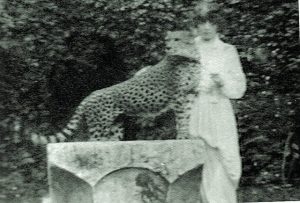
Luisa Casati with one of her cheetahs
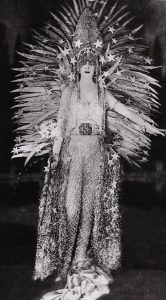
Luisa as St Sebastian
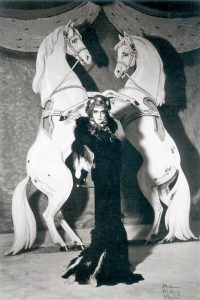
The Marchesa Casati, photographed by Man Ray.
Jack soon married Cristina and they ran off to the South Seas and lived for a time on the island of Moorea (after which he named their daughter). Jack painted several canvasses and then went to Mexico to show his work to Diego Rivera, whom he revered as both an artist and a fellow Marxist. Rivera was so impressed he engaged Jack as his assistant and took him on as a pupil.
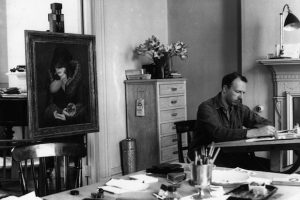
The Red Earl at work and play, and below left, his wife Cristina
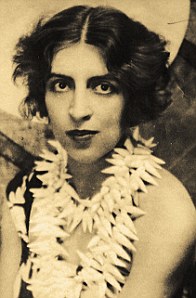
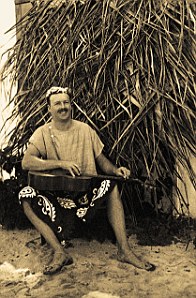
There he lived for nearly a decade, in between trips to Hollywood, where his notoriety caused him to be much in demand and, as he told my father, he socialised with Douglas Fairbanks, John Barrymore, Ronald Colman, Dietrich, Livvie, whom he attempted to kiss, and – most importantly – a newly famous Errol Flynn. Jack and Errol had something in common apart from being rebels with a taste for young women and living close to the edge.
The family tradition was that the Earls of Huntingdon were directly descended from Robin Hood, a claim supported by English folklore (the title of Earl of Huntingdon has often been associated with Robin Hood). Some of the male Earls have been given the name Robin, and the present Earl of Huntingdon is called William Edward Robin Hood Hastings-Bass.
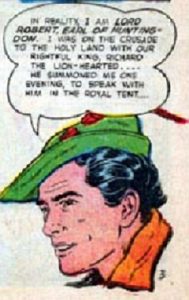
When Jack heard that Errol was to play Robin Hood in a film, he jotted down some notes. One was:’It must be made clear that he is the Earl of Huntingdon.’ Another said: ‘Your moustache should be grown thicker, like mine,’! He was rather annoyed when both these directives were ignored.
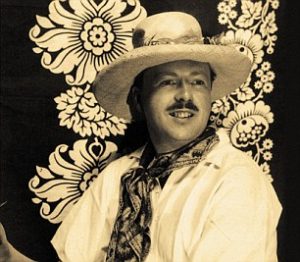
The Red Earl’s Moustache
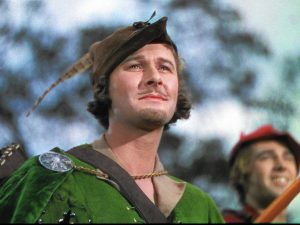
Errol’s Robin Hood Moustache
Jack could be volatile. He was so wedded to the idea that he was a descendent of Robin Hood that when one man had the temerity to question the outlaw’s historical existence, Jack threw him down the stairs.
His marriage to Cristina failed, partly due to her being equally hot tempered. Though she claimed to be a Communist, she once hit her maid so hard she broke her arm. After they divorced, Jack married the novelist Margaret Lane.
Jack Hastings was a man of unique talent as an artist who has now become known as ‘The English Diego Rivera.’ He painted a mural for my father called ‘The Snake in Eden,’ which he had hung in our dining room in Italy over the objections of some, who found it a trifle explicit. His murals are now considered lost masterpieces as very few exist. There is one in the Marx Memorial Library in London and two in the US. I would be fascinated if anyone knew the whereabouts of other murals. In the meantime, there is a wonderful biography of Jack, called ‘The Red Earl’, by Selina Hastings, his other daughter. I recommend it strongly, as he and the Flynnster were definitely fellow travellers!
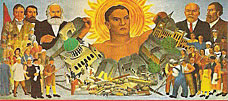
One of Jack’s political murals
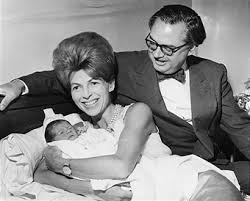
My father with Moorea and my brother, Pericles.
— PW
To all Errol Flynn Blog members, wishing you a Very Merry Christmas from Australia! Here’s my annual handmade Christmas Greeting Card creation.
My first time posting it on EFB, as this year I’ve included an ode to Errol … he being the Santa (from Escape Me Never) escaping the frame at stage left! Enjoy, I raise my glass!
Cheers, Philip
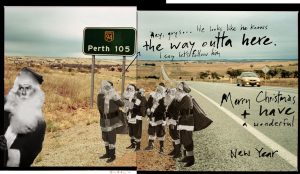
— Philip
In an interview following a standing ovation for his latest film as director ‘Hacksaw Ridge’ at the Venice Film Festival, Mel Gibson listed Raoul Walsh’s ‘Objective, Burma’ – and our man Flynn – as his war movie touchstone:
“I love that film [Objective, Burma] and its way of dealing with war in the Pacific, in hindsight. Things were heavily censored back then and you couldn’t show a lot of awful things, but it was kind of suggested. Raoul Walsh directed it and Errol Flynn parachutes into Japanese-occupied Burma in hopes of destroying a critical radar base. The mission is a success but the group reaches the air strip where they expect to find planes ready to fly them to safety. Walsh was one of the f*cking greats. He had an eye patch, like some kind of pirate. Walsh made some great movies. The choices he makes inObjective, Burma, they really horrify you about war, and this was in the ’50s.”
Read the full article here:
deadline.com…
— Philip
While we are exchanging knowledge about Errol’s idiosyncrasies here is another quiz:
In which movie did Errol mentioned a name, which existed for real in his private life?
— Tina
Hello all Errol fans!
I found this excellent and truthful biography written by Meredith Grau of Errol and I thought you just might enjoy it as much as I did!
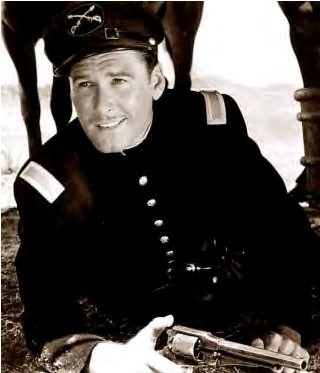
Errol Flynn: swashbuckler, rascal, swaggering screen star with a sinful dose of sex-appeal. I incorporated a lot of S’s into that description in order to produce the steaming hot alliteration that this actor deserves: “Tsssssssssssssssssss… Ouch!” (Don’t get burned, ladies).
During Errol’s reign as the pinnacle action star in Tinsel Town, having inherited the sword from silent hero Douglas Fairbanks, he powered Hollywood with enough electric charisma to solve the entire nation’s energy problems. However, his glamorous, alluring, and death-defying persona of light-hearted nonchalance, while widely accepted by fans, was both true and false. He was promoted as a handsome devil, lady-killer, and man’s man (albeit in an occasional pair of tights) who always got the bad guy and could– and for the most part did– have any woman he wanted. Indeed, Errol was an adorable bad boy, and debates continue to wage about just how naughty he really was.
Permanently emotionally scarred by the childhood abuse he suffered from his mother, Errol also lived with unresolved feelings of neglect. All but abandoned by both parents at school while they went abroad, he spent most Christmas breaks alone in an empty schoolhouse, which in his own mind, felt like a penitentiary. His rebellion against this isolation built him into a troublemaking adolescent, begging for both attention and discipline. He loved to push buttons, but he circumnavigated anyone who sought control over his life. Errol would continue to both seek and avoid the company and demands of others. He lacked the necessary trust and support demanded of obedience. As such, the teen who got kicked out of school would grow into the movie star who consistently irked and disobeyed Jack Warner in business and loathed all authority figures in general. His quest for affection can too be interpreted in his sexual indulgences. Errol had (and boasted of) many lovers, made many conquests, but he sadly had little experience or understanding of love. Flings were pleasurable distractions that never satiated the need he had to find something more. His life was an eternal adventure for some mysterious, missing thing– his own personal El Dorado. What he truly sought– acceptance, enduring love, and happiness– were within arm’s reach, but his itchy feet and lack of trust compelled him to seek beyond the horizon. After all, if one keeps moving, he has no time to be hurt.
Needless to say, Errol had a way of… overdoing it– maniacally burning the candle at both ends in the hopes of quelling the inner madness and despair that had and would never find safe harbour. He wandered the world, spending his youth voyaging from place to place and country to country on almost ludicrously unrelated business ventures– from journalism to running a tobacco plantation in New Guinea! He would also spend his later years literally adrift. Aboard his yacht, the Zaca, he found a sense of quiet away from the pain of the past and the superficiality of his Hollywood life, but this was a sorry substitute for the merciful sensation of peace that comes with the true satisfaction of one’s happiness. The closest he came to joy was Jamaica. Spending time with equally conflicted friends throughout his life, those that unfortunately exacerbated and influenced his darker tendencies (“Jack” Barrymore, Bruce Cabot, etc.)
Errol drank too much, smoked too much, and eventually suffered from morphine addiction, which weathered his initially exquisite, God-given form into a prematurely old body, a reflection of his broken spirit.
The great shame of his life was the tagline “In Like Flynn,” an unfortunate leftover from the statutory rape scandal that forever ruined Errol’s personal reputation and public image. Found innocent of the accusations made against him by Betty Hansen and Peggy Satterlee in the early forties, the court case under modern investigation bears all the tell-tale signs of a set-up, and it is often hypothesized that politicos with a vendetta against the less than financially generous Jack Warner decided to take down his biggest star to teach the mogul a “lesson.” Whether or not Errol had earthly fun with either of these ladies, whether or not he knew their true ages if so, remains debatable. In any case, both Betty and Peggy, who had once enthusiastically volunteered for a place in the movie star’s bed, mysteriously changed their tunes when the prospect of money was dangled before in their faces.
While the contradictory evidence produced in court ended in a mercifully “not guilty” verdict, the event itself had a devastating effect upon Errol, who grievously felt a slight against his personal character. He had already endured the shame of receiving a 4F classification, which kept him out of WWII and insulted both his bravery and masculinity, but this was worse. His popularity had been boosted, but he found himself lampooned as a distasteful, sexual joke. This was a grave personal disappointment, as he idolized his educated, scientist father. His desire to prove himself as an honourable and intelligent man– being impressively self-taught for the most part– revealed itself in his love of writing books, studying any and everything, and approaching more mature cinematic material with a talent that had only improved and aged with him. Unfortunately, Errol found himself locked into the inflexible Hollywood system– a disaster for someone with his need for freedom– and he was never fully able to exercise the personal depth and desire he had for his art. He felt that his gifts were purely superficial and considered himself a laughing stock. In keeping with his mistrustful mindset, while he desired respect for his work, he brushed off all compliments, never believing that his efforts had been worthy. This is the true tragedy, because they absolutely were!
This Irish lad and “Tasmanian Devil” had only done some modest theatrical work and had completed a meager handful of films, including Australia’s The Wake of the Bounty (playing Fletcher Christian, under whose leadership one of his own descendants had mutinied!), when he achieved his breakthrough performance in Captain Blood– with ultimate leading lady Olivia De Havilland, no less. In the demanding, starring role, Errol would prove himself a clear natural before the camera, and this unexpected cinematic success, accomplished by an unknown nobody, consequently initiated an unparalleled career in the movies. His simple delivery of daunting lines, which would leave a lesser actor feeling foolish or tongue tied, and his assertive, graceful movements on the screen– in whatever costume, from whatever era, holding whatever prop– revealed a man who exuded the confidence of an overgrown boy. He presented himself as a brazen acrobat, completely disinterested in consequences and desirous only of living with relished abandon. His love interests were always of secondary importance to the rush of battle– a parallel with his own life. From pirate (The Sea Hawk), to cowboy (Dodge City), to war pilot (The Dawn Patrol), to sad anti-hero (That Forsyte Woman), to martyr (Uncertain Glory), to icon (Robin Hood), Errol was always excitingly up to any challenge, and as a result, he continuously succeeded in getting his audiences to believe in and cheer for him in whatever rogue battle he fought from film to film. What’s more, he also looked damn good doing it.
They don’t make Errol Flynns anymore, not that “they” could if they tried. So many filmmakers and performers try to duplicate the magic that Errol naturally possessed, but Hollywood’s current offerings of reconstituted leading men lack the elegance, spirit, and sincerity of Flynn. His characters, with their mortal vanity and foolhardy embrace of danger, exist at a level of liberty that today’s action heroes, with pecs but no personality, cannot understand. No… No one will ever be “in like Flynn” again. But that is only because Flynn is forever.
______________________________________________________________
Below you find the comments posted by fans, which all our fellow Flynnians may enjoy:
Beautifully written post. xox
Thank you kindly, lady! I appreciate it!:)
Very nice write up!
Answer by Meredith:
Thank you, kindly! Errol is such a difficult personality to capture, and is too often portrayed unsympathetically. It is always nice to hear positive reactions to my depictions. Thanks for stopping by! :)
I have read an awful lot about Mr. Flynn and I must say you have written a very fair and concise profile of my favourite star. An extremely indulgent librarian and in 1966 let a skinny thirteen year old with glasses check out from the Adults Only section, My Wicket, Wicket Ways. (“I believe Errol Flynn led a colourful life,” she said smiling at me!). It probably changed my life. Pick yourself up when they knock you down and keep laughing lads and lasses.
That’s what I learned from him. Just one note: Murder at Monte Carlo, a “lost film” was his second film, not Captain Blood. Lovely job, Meredith!
Answer by Meredith:
Thank you so much for your kind words! I appreciate the note as well, which I will certainly correct and incorporate. Errol’s an easy fellow to love, but I respect him as well, which I feel was what he would have appreciated more. Happy Memorial Day!
Answer by Meredith:
Haha, no worries! I write so many typos that my prose might as well be in Swahili! I sincerely appreciate your comments and am very appreciative for the catch on “Murder at Monte Carlo.” I always forget about that one! I am with you 100% on Mr. Flynn. His work and presence always put me in a good mood and bring me back to life when I’ve had one too many punches. It’s always nice to meet another fan. Take care and stay in touch! :)
Dear Meredith Grau!
Thank you so much for your exquisite reportage on Errol Flynn is the nicest I have ever read in my life. It is written with such inside to his psychology and portraying a realistic picture of this great actor and superb man he was. Errol Flynn has given us so much pleasure with his movies and still does when we see him on TCM, which is always a thrill!
Answer by Meredith:
Thank you for your response! I truly admire and respect Mister Flynn, in addition to finding him hugely entertaining. The fan loyalty that has remained so long after his premature death is very moving. He’s still the one to beat as far as I’m concerned when it comes to charismatic leading men.
Very nice write-up but may I point out one mistake: the marriage of Damita and Curtiz is a myth, it never happened. One of many Wiki mistakes!
Extremely well done! Very thoughtful, and revealing! You might like The Errol Flynn Blog, too.
Answer by Meredith:
Yes! Was introduced to the EF Blog not long ago! So great to see a community carrying on his memory and correcting some misperceptions many have about the man, his life, and his character. Thanks for your response! :)
An extremely well written article Meredith – congrats!
Answer by Meredith:
Thank you, my friend! It gladdens me that there is still so attention and respect devoted to Mr. Flynn. Of all the actors I touch upon here, he seems to be the one about whom I can initiate the most dialogues. He remains the ultimate screen hero and a truly beautiful, misunderstood, complicated man. ;)
Excellent article. There is one mistake, under his picture at the top of the page, you have his birthday as July 20, 1909. He was actually born on June 20, 1909. Other than that, this was a very well written article that focused on Flynn as a person and not just him as a salacious figure in movie history– which, as a fan of Flynn, is much appreciated.
Answer by Meredith:
Ooh! Thanks for the catch! I write so fast most of the time, and by the time I have read and reread, all the words start blending together! I will make the correction right away. Thanks for stopping by and for your lovely comments. The public’s love of Flynn continues unabated since his death, which I believe is something that would warm his heart, so long as the messages passed along are honest. :)
Such sincere and fitting description of a one-of-the-century icon and this larger-than-life while self-destructive hero of ours! For decades have passed, Errol is still with us because we truly love, admire and sympathize with him. He was and still is the most handsome, dashing, magnetic mega star. RIP, the great Errol of ours.
I may add:
Your writing is so delicious and your analysis of Errol is very close to the truth!
Enjoy!
— Tina
…I hope this works. I ran across this set of Adventures of Robin Hood lobby cards on tumblr this morning and just had to share. They look hand-colored to me. Apologies if they have been posted before, I looked back through the library a bit but didn’t see them.
— Paula